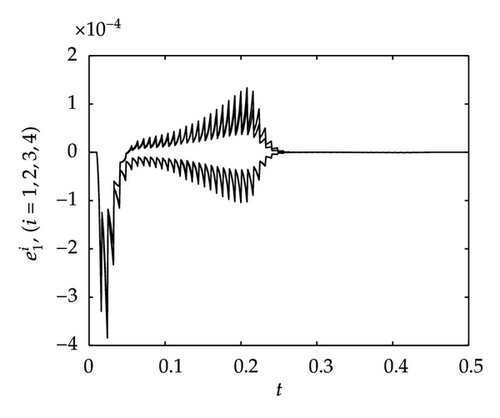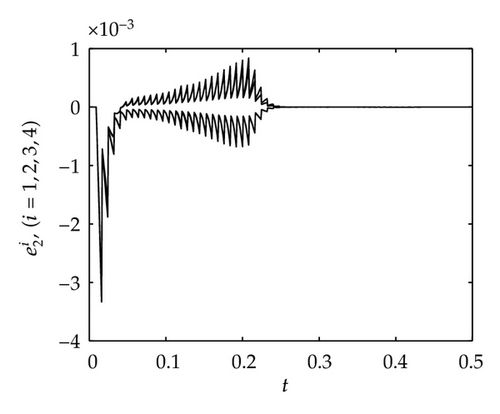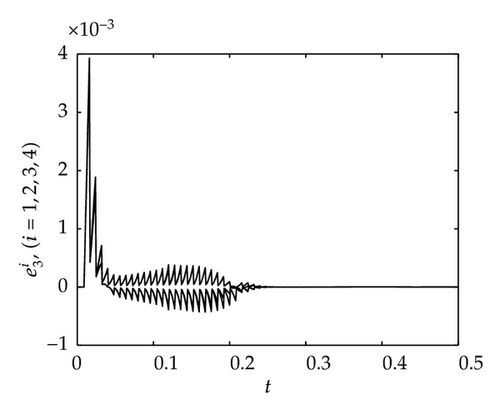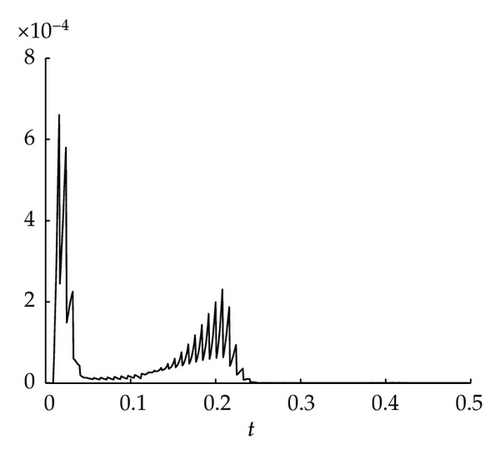Impulsive Synchronization of Multilinks Delayed Coupled Complex Networks with Perturb Effects
Abstract
This paper investigates impulsive synchronization of multilinks delayed coupled complex networks with perturb effects. Based on the comparison theory of impulsive differential system, a novel synchronization criterion is derived and an impulsive controller is designed simultaneously. Finally, numerical simulations demonstrate the effectiveness of the proposed synchronization criteria.
1. Introduction
In the past few decades, the problem of control and synchronization of complex dynamical networks has been extensively investigated in various fields of science and engineering due to its many potential practical applications [1–8]. One important consideration in practical networks is the existence of time delays because obstructions to the transmission of signals are inevitable in a biological neural network, in an epidemiological model, in a communications network, or in an electrical power grid. Since recently, there are many studies on dynamical networks with time delays [9–16]. Moreover, the multidelayed coupling consists of providing more information about the dynamics in nodes to the other nodes in the network, such as the transportation network; we all know that the transmission speed is different among highway network railway network, and airline network. So we can use timedelay to describe these networks [17]. In [17], the authors studied synchronization of a class of timedelayed complex dynamical networks with multilinks, and this model is suitable to investigate and simulate more realistic complex networks, so we should pay attention to this network with multilinks. Moreover, in [9–11, 17–20], the authors studied synchronization of complex network with time-varying coupling delay by designing a controller and adaptive updated laws. However, the controller designed for such an adaptive synchronization is usually quite complex, it will be useful to find a simple structure to solve this problem, the impulsive controller seems to have a simple structure, and impulsive control is an artificial control strategy which is cheaper to operate compared with other control strategy. Motivated by the above discussions, we investigate impulsive synchronization for such a complex networks model in this paper, and the novel synchronization criterion is derived.
The rest of this work is organized as follows. Section 2 gives the problem formulation. Section 3 gives synchronization scheme. Section 4 gives illustrative example. Section 5 gives the conclusion of the paper.
2. Problem Formulation
Remark 2.1. In [17], is defined, we are not concerned whether the coupling matrix Al satisfies in this paper.
In the paper, we have the following mathematical preliminaries.
Assumption 2.2. We assume that f(xi(t)) is Lipschitz continuous on xi(t), that is, there exists a positive constant η > 0 such that
Assumption 2.3. We also assume that σ(xi(t)) is Lipschitz continuous on xi(t), and one can consider
3. Synchronization Scheme
Theorem 3.1. Let Assumptions 2.2–2.3 hold, , r = 1,2, …, m. If there exists a constant θ ≥ 1 such that
Proof. We choose a nonnegative function as
Then the differentiation of V along the trajectories of (3.4) is
On the other hand, when t = tk, we have
When t ∈ (t0, t1], , then
When θ ≥ 1, from [21], this implies that the origin in system (3.4) is globally asymptotically stable or the driving network is synchronized with the response network asymptotically for any initial conditions. This completes the proof.
Remark 3.2. Systems (3.1)-(3.2) are the time-invariant complex networks. As discussed in [22–24], systems (3.1)-(3.2) are the time-varying complex networks, which is a more complicated research issue.
Remark 3.3. Normally, it is difficult to control a complex networks by adding the controllers to all nodes, so it would be much better to use the pinning control method since the most complex networks have large number of nodes [25]. Regarding for the pinning control of the network systems (3.1)-(3.2), are the next research topic for us.
Remark 3.4. For the transportation network, we all know that the transmission speed is different among highway network, railway network and airline network. So we can use multilinks delayed to describe these networks [17]. Also impulsive control is an artificial control strategy which is cheaper to operate compared with other control strategy, so impulsive control method of the network systems (3.1)-(3.2) should have potential applications.
4. Illustrative Example
It is well known that the Lü attractor is bounded. Here we suppose that all nodes are running in the given bounded region. Our numerical analyses show that there exist constants M1 = 25, M2 = 30, M3 = 45.




5. Conclusion
This paper deals with the problem of impulsive synchronization of multilinks delayed coupled complex networks with perturb effects. On the basis of the comparison theory of impulsive differential system, the novel synchronization criteriion is derived and an impulsive controller is designed simultaneously. Finally, numerical simulations are presented to verify the effectiveness of the proposed synchronization criteria.
Acknowledgments
The authors would like to thank the referees and the editor for their valuable comments and suggestions. This research is supported by the National Natural Science Foundation of China (61075060), the Science and Technology Research Key Program for the Education Department of Hubei Province of China (D20105001 and D20126002), the Excellent Young Key Talents Cultivation Plan of Hubei Province, China Postdoctoral Science Foundation (2012M511663), the Research Fund for the Technology Development Program of Higher School of Tianjin (20111004), the Social Science Planning Project of Tianjin (TJLJ11-009), and the young talents Fund of Anhui Provinc of China (2011SQRL164).




